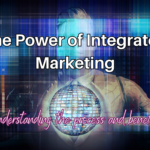Integrated marketing is a marketing strategy that involves the coordination and integration of various marketing channels and tactics to create a seamless and consistent brand message and customer experience. It is an approach that focuses on creating a unified and holistic marketing strategy that is aligned with the brand’s overall business goals and objectives. In this blog post, we will explore the different elements of integrated marketing, its benefits and challenges, and how to create an effective integrated marketing strategy.
Understanding Integrated Marketing
Integrated marketing is not a new concept; it has been around for many years, but its importance has increased with the rise of digital marketing and the proliferation of marketing channels. In the past, marketing was primarily done through traditional media channels such as TV, radio, and print. These channels were used in isolation, with little or no coordination between them. This resulted in a fragmented and inconsistent brand message and customer experience.
The rise of digital marketing has changed this. Today, marketers have access to a plethora of digital marketing channels such as social media, email marketing, content marketing, and search engine marketing, among others. These channels provide marketers with the opportunity to reach their target audience in a more targeted and personalized way.
However, this increased fragmentation of marketing channels has also created a need for a more coordinated and integrated approach. Integrated marketing aims to create a seamless and consistent brand message across all marketing channels, resulting in a better customer experience and improved business outcomes.
Elements of Integrated Marketing
Integrated marketing involves the integration of various marketing elements such as branding, advertising, sales promotion, public relations, direct marketing, and personal selling. Let’s take a closer look at each of these elements.
Branding
Branding is the process of creating a unique and consistent brand identity that sets the brand apart from its competitors. It involves creating a name, logo, tagline, and other visual and verbal elements that represent the brand’s values, personality, and promise.
In an integrated marketing strategy, branding is critical as it provides a consistent and recognizable brand identity across all marketing channels.
Advertising
Advertising is a paid marketing communication that promotes a brand’s products or services to a target audience. It includes various types of advertising such as TV, radio, print, outdoor, and digital advertising.
In an integrated marketing strategy, advertising plays a critical role in creating brand awareness and generating leads.
Sales Promotion
Sales promotion refers to the use of incentives such as discounts, coupons, and free samples to stimulate demand and encourage sales. It is a short-term tactic that is used to boost sales.
In an integrated marketing strategy, sales promotion is used to complement other marketing channels such as advertising and direct marketing.
Public Relations
Public relations (PR) is the practice of managing the spread of information between a brand and its audience. It involves building relationships with the media and other stakeholders to create a positive image for the brand.
In an integrated marketing strategy, PR is used to create a positive brand image and reputation, which can help in building customer trust and loyalty.
Direct Marketing
Direct marketing involves communicating directly with a target audience through various channels such as email, direct mail, and telemarketing. It is a personalized and targeted approach that aims to generate leads and convert them into customers.
In an integrated marketing strategy, direct marketing is used to complement other marketing channels such as advertising and sales promotion.
Personal Selling
Personal selling involves one-on-one communication between a salesperson and a potential customer. It is a personalized and persuasive approach that aims to build relationships with customers and close sales.
In an integrated marketing strategy, personal selling is used to complement other marketing channels such as advertising and direct marketing.
Also Read:
Which is the best digital marketing agency?
Benefits of Integrated Marketing
Integrated marketing offers many benefits to businesses. Let’s take a look at some of the most important benefits of integrated marketing.
Consistency
One of the most significant benefits of integrated marketing is consistency. By creating a unified and holistic marketing strategy, businesses can ensure that their brand message is consistent across all marketing channels. This consistency creates a sense of familiarity and trusts with customers, which can lead to increased brand loyalty and repeat business.
Improved Brand Awareness
Integrated marketing can also improve brand awareness. By using a variety of marketing channels, businesses can reach a wider audience and increase their brand exposure. This increased exposure can lead to increased brand recognition and recall, which can help businesses stand out from their competitors.
Increased ROI
Another important benefit of integrated marketing is increased ROI. By using a coordinated and integrated approach, businesses can ensure that their marketing efforts are aligned with their business goals and objectives. This alignment can result in more effective marketing campaigns that generate higher returns on investment.
Enhanced Customer Experience
Finally, integrated marketing can enhance the customer experience. By creating a seamless and consistent brand message across all marketing channels, businesses can provide customers with a more personalized and engaging experience. This personalized experience can lead to increased customer satisfaction and loyalty.
Challenges of Integrated Marketing
While integrated marketing offers many benefits, it also poses some challenges. Let’s take a look at some of the most significant challenges of integrated marketing.
Coordination
One of the biggest challenges of integrated marketing is coordination. Coordinating multiple marketing channels and tactics can be difficult, especially if they are managed by different teams or agencies. To overcome this challenge, businesses need to establish clear communication channels and processes to ensure that all marketing efforts are aligned.
Communication
Another challenge of integrated marketing is communication. Effective communication is essential to ensure that all marketing efforts are coordinated and aligned with the brand’s overall business goals and objectives. Businesses need to establish clear communication channels and processes to ensure that all stakeholders are aware of the marketing strategy and their roles in executing it.
Consistency
Consistency is another challenge of integrated marketing. Creating a consistent brand message across all marketing channels requires a significant amount of effort and attention to detail. Businesses need to ensure that all marketing efforts are aligned with the brand’s values, personality, and promise.
Evaluation
Finally, evaluating the effectiveness of an integrated marketing strategy can be challenging. Measuring the ROI of individual marketing channels and tactics can be difficult, especially if they are integrated into a broader marketing strategy. Businesses need to establish clear metrics and KPIs to measure the effectiveness of their marketing efforts.
How to Create an Integrated Marketing Strategy
Now that we have explored the different elements of integrated marketing, its benefits and challenges, let’s take a look at how to create an effective integrated marketing strategy.
Identify Your Target Audience
The first step in creating an integrated marketing strategy is to identify your target audience. Who are your ideal customers, and what are their needs, wants, and pain points? Understanding your target audience is critical to creating a marketing strategy that resonates with them.
Develop Your Marketing Goals
Once you have identified your target audience, the next step is to develop your marketing goals. What are you trying to achieve with your marketing efforts, and how will you measure success? Your marketing goals should be aligned with your business goals and objectives.
Choose Your Marketing Channels
The next step is to choose your marketing channels. Which marketing channels are most effective in reaching your target audience, and how will you integrate them into your marketing strategy? Remember to consider both traditional and digital marketing channels.
Develop a Consistent Brand Message
The key to successful integrated marketing is a consistent brand message. Develop a clear and concise brand message that reflects your brand’s values, personality, and promise. This message should be consistent across all marketing channels.
Integrate Your Marketing Efforts
Once you have developed your marketing goals, chosen your marketing channels, and developing your brand message, it’s time to integrate your marketing efforts. This means ensuring that all marketing channels and tactics are coordinated and aligned with your brand’s overall business goals and objectives. Develop a clear plan that outlines how you will integrate your marketing efforts across all channels.
Measure Your Results
Finally, it’s essential to measure the results of your integrated marketing strategy. Establish clear metrics and KPIs to measure the effectiveness of your marketing efforts. Regularly analyze your results and make adjustments as needed to improve the performance of your marketing campaigns.
Conclusion
Integrated marketing is a powerful approach to marketing that can help businesses achieve their marketing goals and objectives. By coordinating and integrating multiple marketing channels and tactics, businesses can create a unified and holistic marketing strategy that generates higher ROI, increases brand awareness, and enhances the customer experience. However, integrated marketing also poses some challenges, such as coordination, communication, consistency, and evaluation. To create an effective integrated marketing strategy, businesses need to identify their target audience, develop their marketing goals, choose their marketing channels, develop a consistent brand message, integrate their marketing efforts, and measure their results. With a well-executed integrated marketing strategy, businesses can stand out from their competitors and build strong relationships with their customers.










0 Comments